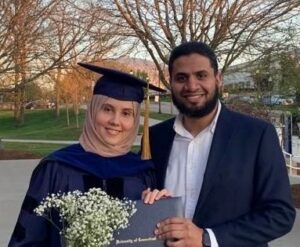By Brandon T. Bisceglia

Islam Mosa and Esraa Nasanadidy.
Deep brain stimulators are implantable devices that can serve as an important tool for treating certain diseases, such as Parkinson’s. But they suffer from a major drawback: the battery needs regular changing via surgery.
Now a team of researchers at UCONN, including Orange couple Islam Mosa and Esraa Elsanadidy, have demonstrated a new way to power these devices by harnessing the user’s own breathing.
Deep brain stimulators typically contain a power source implanted in the chest connected via wires to a series of electrodes placed within the brain. The power source delivers electrical pulses to targeted portions of the brain. These devices have been used to help people with both neurological and psychological issues. In addition to Parkinson’s, it has been used to treat problems like epilepsy and obsessive-compulsive disorder.
Normally, the DBS system is powered by a battery implanted in the chest, much like a pacemaker. However, it has a much shorter lifespan: only two or three years. Each battery change requires a new surgery.
“It’s extra pain, high risk of infection, and also the extra cost,” Mosa said of the repeat surgeries.
Mosa’s and Elsanadidy’s research, published Oct. 11 in the journal Cell Reports Physical Science, showed that it was possible to use something called a triboelectric nanogenerator to generate the needed power, eliminating the need for a battery altogether.
Triboelectric generators turn mechanical energy – motion – into electric energy through friction. They have been used in other applications, such as by using the mechanical power of ocean waves to create energy.
Friction creates static electricity, a source of energy that Mosa noted people would be familiar with in their everyday lives – most spectacularly in the phenomenon of lighting.
“Two airflows, one hot and one cold, when they have friction between each other generates this enormous amount of energy – millions of volts,” he said.
Mosa’s nanogenerator produces much smaller amounts of energy, but through a similar process. Two materials with properties like the positive and negative ends of a battery are placed very close to each other but separated by a small gap.
When someone implanted with the generator in their chest breathes, the motion closes the gap between the materials.
“When there’s any vibration, they touch each other and separate,” Mosa said. “This generates that electricity.”
The energy harvested by the nanogenerator is then sent via wires to a supercapacitor, which powers the electrodes in the brain.
Mosa said an added benefit of the nanogenerator is that it’s significantly smaller than the batteries it is meant to replace.
The research team has so far tested its invention in a model made by connecting “healthy pig lungs to an air pump, then installing them into an artificial human rib cage,” according to the study. The system was able to produce the same types of pulses as the current, battery-powered systems.
“This was one way to test the efficiency of the system, as a proof of concept,” Mosa said. He added that the UCONN group is applying for research funding for the next stage, which will requite testing the system in a live animal.
In the meantime, he is also pursing commercial licensing and development via his company, VoltXon, which was formed to bring inventions like the nanogenerator to market.
Mosa has been involved with UCONN for a decade, where he completed his PhD and works in the Department of Chemistry with Elsanadidy. They were the first and second authors on the study.
“We’re collaborators in research, and collaborators in life,” he said.
The couple moved to Orange in August, to be close to New Haven-based Alexion Pharmaceuticals, where they also now work. They picked the town because of the school system, low crime and the general atmosphere.
Mosa said Orange is a “magnificent” place to live.
“It’s very different from Storrs. There, everything is at least 15 minutes away. Orange is much more lively. And we can get anywhere in three minutes,” he said.